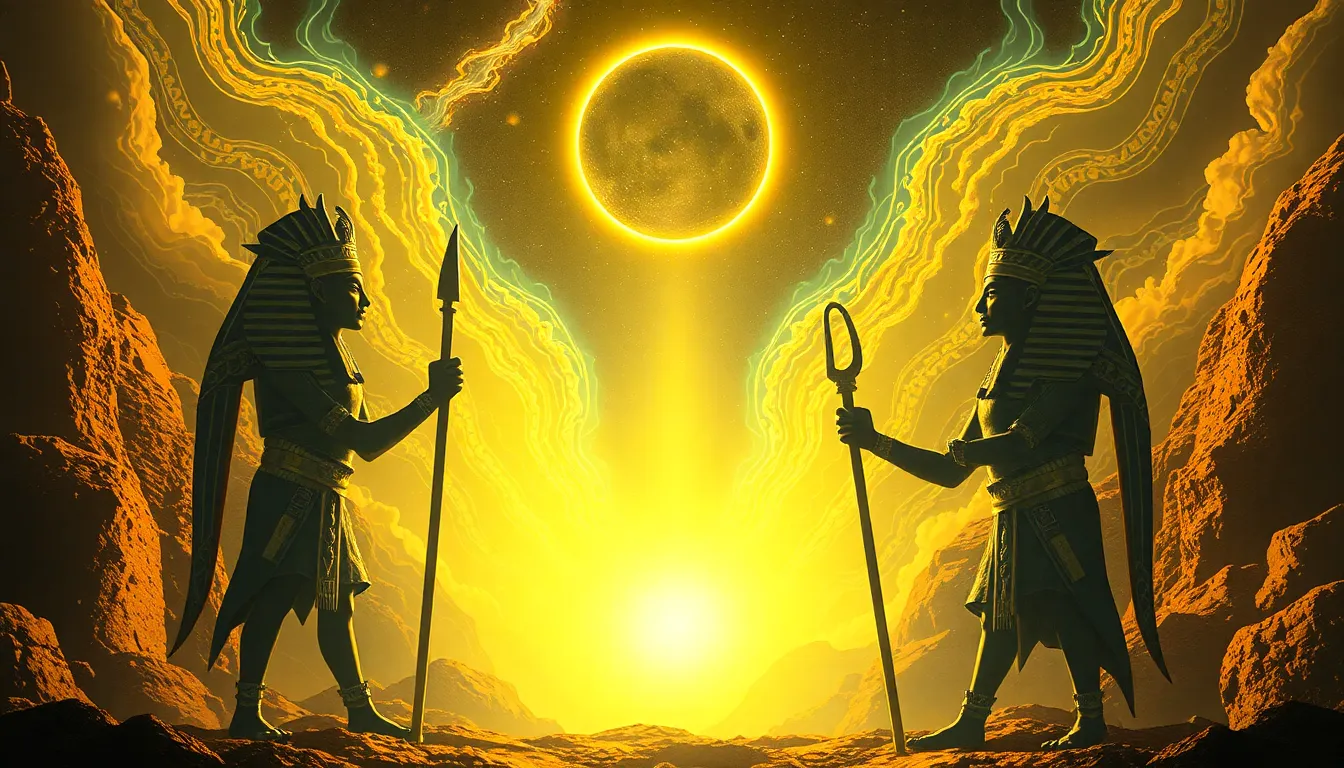The Role of the God Ra in Creation and Renewal
I. Introduction
Ancient Egyptian mythology is a rich tapestry of gods, goddesses, and creation stories that have fascinated scholars and enthusiasts alike for centuries. Central to this mythology is the sun god Ra, who holds a significant position in Egyptian cosmology. Ra is not only a god of the sun but also a symbol of creation and renewal, representing the cyclical nature of life and death.
The purpose of this article is to explore the multifaceted role of Ra in Ancient Egyptian mythology, particularly his significance in creation, renewal, and the maintenance of cosmic order.
II. The Mythological Origins of Ra
Ra’s origins are deeply embedded in the primordial waters of chaos, known as Nun. From these waters, Ra emerged as a self-created deity, symbolizing the dawn of existence.
- Ra’s Emergence from the Primordial Waters: Ra is often depicted rising from the waters of Nun, signifying the beginning of creation.
- The Concept of Atum: Atum, another creator god, is associated with Ra in various myths, where he creates the first gods from himself.
- Ra’s Role as the Sun God: As the sun god, Ra embodies the life-giving force of the sun, crucial for sustaining life on Earth.
III. Ra’s Daily Journey Across the Sky
The journey of Ra across the sky is one of the most important aspects of his mythology, symbolizing the cycle of life, death, and rebirth.
- The Symbolism of the Sun’s Cycle: The rising and setting of the sun represent the eternal cycle of day and night.
- The Journey of Ra as a Metaphor: Ra’s journey through the sky can be seen as a metaphor for the journey of life, where each day brings new challenges and opportunities.
- The Significance of Dawn and Sunset: The moment of dawn is seen as a time of renewal, while sunset symbolizes the end of life, followed by rebirth.
IV. Ra and the Concept of Ma’at
Ma’at is a fundamental concept in Ancient Egyptian belief, representing order, truth, and justice. Ra plays a crucial role in upholding Ma’at within the cosmos.
- Understanding Ma’at: Ma’at is personified as a goddess and is essential for maintaining harmony in the universe.
- Ra’s Role in Maintaining Cosmic Order: As the sun god, Ra’s daily journey reinforces the principles of Ma’at by ensuring the rhythm of time and the cycles of nature.
- The Connection between Creation, Renewal, and Ma’at: Ra’s creation and renewal processes are interwoven with the principles of Ma’at, highlighting the importance of balance in the universe.
V. Ra in Egyptian Creation Myths
Ra appears in various creation myths, illustrating the diversity of Egyptian cosmology.
- Different Versions of Creation Involving Ra: Various texts describe how Ra created the world, each offering unique perspectives.
- The Heliopolitan Creation Myth: In this myth, Ra is central to the pantheon of gods, creating the first deities through his own will.
- Ra’s Offspring: Ra’s children, such as Shu (air) and Tefnut (moisture), play essential roles in creation and the continuation of life.
VI. The Role of Ra in Renewal and Regeneration
Ra’s influence extends beyond creation; he is also a symbol of renewal and regeneration, celebrated through various festivals and natural events.
- Festivals and Rituals Honoring Ra: The ancient Egyptians held numerous festivals to honor Ra, including the Wepet-Renpet, which celebrated the new year.
- The Significance of the Annual Flooding of the Nile: The inundation of the Nile was seen as a manifestation of Ra’s power, bringing fertility and abundance to the land.
- Ra’s Influence on Agriculture: As the sun god, Ra’s light and warmth were essential for crop growth and the agricultural cycle.
VII. Ra in the Afterlife and Eschatology
Ra’s importance extends into the afterlife, where he guides the souls of the deceased through the Duat, the Egyptian underworld.
- The Journey of the Deceased with Ra: Upon death, a soul is believed to travel with Ra through the Duat, facing challenges and ultimately seeking judgment.
- The Concept of Rebirth and Immortality: Ra embodies the idea of rebirth, where the soul is renewed and transformed after death.
- Ra’s Role in the Judgment of Souls: Ra participates in the judgment process, weighing the heart of the deceased against the feather of Ma’at to determine their fate.
VIII. Conclusion
In summary, Ra’s multifaceted role in Ancient Egyptian mythology encompasses creation, renewal, and the maintenance of cosmic order. His journey across the sky is a powerful metaphor for life and the cyclical nature of existence. Ra’s enduring legacy continues to resonate in contemporary culture, illustrating the significance of sun worship and the natural cycles that govern our lives.
Understanding Ra is essential for grasping the complexities of Ancient Egyptian beliefs, as he embodies the principles of life, death, and the eternal renewal that defines the human experience.




